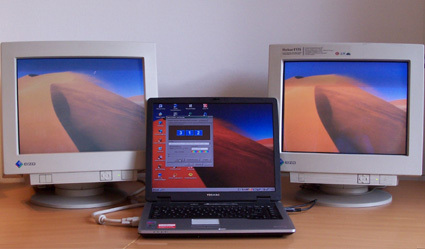Add A Monitor Using USB: Sitecom's VGA Adapter
More Desktop Space: Sitecom USB 2.0 VGA Adapter
You might start to feel like your Windows desktop is actually shrinking, given the onslaught of utilities and applications competing for its limited space. Those of our readers working on a screen using a resolution of 1024x768 or even less will be especially aware of this problem. In such cases, a second monitor can be a good solution - but only if your graphics card or notebook offers a second monitor output.
Increasingly, notebooks are being used as desktop replacements - in 2004, notebook sales actually surpassed those of desktop systems for the first time. In cases where such desktop replacements are used for CAD or photo/video editing, desktop real-estate is at a real premium. Consequently, users may soon feel the need for more space, even if just for such mundane tasks such as housing email programs, IM windows and system utilities.
Notebooks often don't have internal expansion bays, and those that do rarely use standardized interfaces. This means that in most cases, the selection of available devices is limited to external solutions.
The first step in determining if you can expand your system's graphics capabilities is to check out the graphics interface of the system in question. Desktop graphics cards, for example, have come with two monitor connectors for some time now. The most frequent combination is one VGA and one DVI output, although more recent cards tend to sport two DVI connections. In contrast, while almost all notebooks also come with at least one additional VGA connector for an external display, DVI connectors are still very rare and are only now starting to be more widely seen.
Of course, there are many computers that simply do not have a second graphics output at all. In these cases, the USB 2.0 VGA adapter made by Sitecom might give you the additional graphics capability you need. The device could also come in handy on servers that don't have any graphics hardware at all.
Get Tom's Hardware's best news and in-depth reviews, straight to your inbox.
Current page: More Desktop Space: Sitecom USB 2.0 VGA Adapter
Next Page Installation: Plug & Play?